-
- bimba
- Universal Robots
- dorner
- cobots
- industrial automation nj/ny
- The Knotts Company
- manufacturing
- Dorner Conveyors,
- The Knotts Co
- UR
- Robots
- PLC
- Unitronics
- automation
- humphrey products
- knotts company
- solutions
- HMI
- automation solutions
- cobot
- conveyors
- robotics
- aluminum extrusion
- aluminum extrusion in nj
- engineered solutions
- Robotiq
- air cylinder
- collaborative robots
- cost effective
- cost savings
- t-slotted extrusion
- bimba solutions
- collaborative robot
- technology
- MiR
- Humphrey
- IAI
- WAGO
- assembly
- bimba pneumatic
- machine guard
- smartflex conveyors
- solution
- 2200 Series
- cylinder
- electric cylinder
- motion control
- packaging
- pharmaceuticals
- sanitary conveyor
- Products
- automated palletizing
- automation control
- conveyor
- core competencies
- grippers
- palletizing
- resource
- robot
- AquaPruf
- Asycube
- Asyril
- Belt Conveyors
- Cage Clamp
- Food
- Machine Guarding
- Mobile Robots
- Norgren
- OptoForce
- Pneumadyne
- Pneumatic Valve
- ROBO Cylinder
- UR5
- actuators
- compressed air
- custom solution
- food safety and sanitation
- mobile industrial robot
- quality assurance
- robotics solutions
- safety
- stainless steel conveyors
- vision
- Belts
- Benefits
- Beverage
- Bimba IntelliSense®
- CT Effects
- PLC+HMI
- Proportion Air
- Proportional valve
- Questions
- Success
- UR10
- Vaccon
- automated inspection
- gripper
- improvement
- industrial vision
- intelligent actuator
- labeling application
- labor shortage
- life science
- medical
- medical industry
- pneumatic motion control
- sales process
- sensor
- thomas
- valve
- 3200 series
- 6-axis robot
- 80/20
- Acro
- Automate
- LMI
- Machine
- OnRobot
- Original Line Cylinder
- Pinch Valve
- Precision Technology
- Predictive Maintenance
- Preventive Maintenance
- Product News
- ROBO Cylinders
- ROI
- Reducing Costs
- automated mobile robot
- autonomous mobile robot
- connectors
- controls
- covid
- custom solutions
- customer service
- e-Series
- electric actuator
- electro-mechanical
- end of arm tools
- energy plant
- ethercat
- external resource
- flexmove technology
- guarding
- inspection
- machine control
- manufacturers
- monitoring
- motion
- new product
- outsource
- outsourcing
- packing
- pneumatic actuator
- pneumatic valves
- precision move
- quick response solution
- regulator
- sales tools
- steel frame
- vacuum
- vacuum technology
- welded steel frame
- 7X Series Conveyor
- AMR
- Advantages
- Application
- Applied Motion Products
- Asycube 530
- Asyfeed Pocket
- Balanced Valves
- CNC program
- Continuity Inspection Tool
- Control Panel
- Controllers
- Crowned Pulley
- F22 Series
- Factory Improved Productivity
- Filtration
- Fire Fighting
- Flexible Feed
- Freeze protection
- Gas
- High Pressure Regulator
- IP65
- Inspekto
- IntelliPress
- Intellisense
- International Manufacturing Technology Show 2016
- LARGO A5
- Legos
- MIRAI
- Machine Controllers
- Machine Vision
- Micropsi
- NJ
- NY
- New
- New Scale Robotics
- OEE
- Oil
- Optimization
- PACK EXPO
- PC10
- Parison Blow Molding
- Pick-it
- ProControl Series
- ROEQ
- Rain Test
- Resin Block
- Rio Olympics
- SCHUNK
- Sanitation
- Sensors
- Smart Manufacturing
- Spot Welding
- TRD
- Temperature Controller
- Training
- Trio Manufacturing Technology
- Twist Clamp
- UR3
- UniStream
- Universal
- V-guide
- Valve Assemble
- Vane-Buster
- Versagrip
- Versagrip solenoid pinch valves
- Victory Actuator
- Vision430
- XTR Series
- Yamaha
- balanced solenoid valve series
- bimba electric
- bottle filling
- brewery
- brushless motor
- buna
- center point
- chicane
- cloud
- cobot compliance
- collaborative operation
- compact series
- composite cylinder
- conference
- cost
- date code
- demonstration
- desiccant drier
Get the latest in your inbox.
This post is brought to you by Dorner.
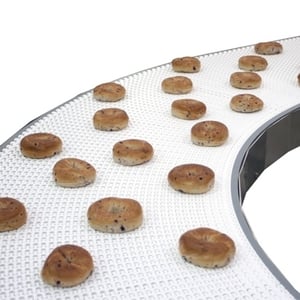 There are many factors that drive food processors to upgrade their conveyor systems to a more sanitary platform. Leading the charge is the Food Safety Modernization Act (FSMA), which takes a more proactive approach toward food safety by adding safeguards to try and prevent contamination or problems from occurring within the nation’s food supply in the first place. Besides the FSMA, companies cannot afford to have a contamination outbreak traced back to poor sanitary designs in their equipment. The risks to their reputation and to their customers’ well-being are too great.
There are many factors that drive food processors to upgrade their conveyor systems to a more sanitary platform. Leading the charge is the Food Safety Modernization Act (FSMA), which takes a more proactive approach toward food safety by adding safeguards to try and prevent contamination or problems from occurring within the nation’s food supply in the first place. Besides the FSMA, companies cannot afford to have a contamination outbreak traced back to poor sanitary designs in their equipment. The risks to their reputation and to their customers’ well-being are too great.
So as companies scrutinize how to improve their food processing practices and stay ahead of the FSMA, installing new sanitary conveyors is often one of the conclusions they arrive at. That’s a sound decision because conveyors are in direct contact with food, especially on the processing side. These conveyors need to be built with strong sanitary attributes to eliminate any chance of contamination. However, not all “sanitary” conveyors are built the same. Let’s take a look at some of the engineering and design differences that make a conveyor a truly sanitary platform.
Is stainless steel truly sanitary?
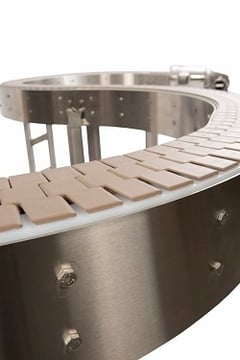 A common misconception is that all stainless steel conveyors are sanitary. When the FSMA was announced a few years ago, many companies went out and purchased stainless steel conveyors thinking they were going to get a high level of sanitary protection. While that purchase provided them with a stainless steel conveyor, they might not have received a truly sanitary conveyor…and there’s a big difference between the two. Here’s why:
A common misconception is that all stainless steel conveyors are sanitary. When the FSMA was announced a few years ago, many companies went out and purchased stainless steel conveyors thinking they were going to get a high level of sanitary protection. While that purchase provided them with a stainless steel conveyor, they might not have received a truly sanitary conveyor…and there’s a big difference between the two. Here’s why:
Stainless steel is certainly the right material to use in applications that call for regular washings with light chemical cleaning agents. A basic stainless steel conveyor can be washed throughout the day as needed, depending on how it’s built, but it’s not necessarily sanitized. That’s because sanitizing a conveyor involves an entirely different process than simply washing it down, and much of achieving a sanitized conveyor depends on the way it was initially designed.
What makes a true sanitary conveyor?
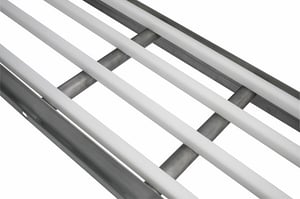 The goal of a sanitary conveyor is to, as best as possible, eliminate any chance of contamination. By their very nature, conveyors are an excellent source of contamination; especially on the processing side where raw food and ingredients are being moved. A sanitary conveyor works to eradicate those areas where contamination can happen…and that starts with the design of the frame.
The goal of a sanitary conveyor is to, as best as possible, eliminate any chance of contamination. By their very nature, conveyors are an excellent source of contamination; especially on the processing side where raw food and ingredients are being moved. A sanitary conveyor works to eradicate those areas where contamination can happen…and that starts with the design of the frame.
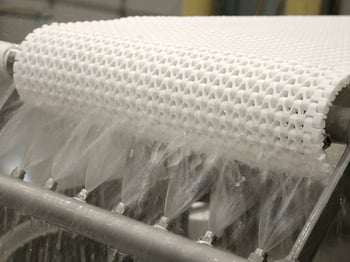 A true sanitary conveyor gives the user full easy access to all areas of the conveyor for cleaning. By being able to reach every part of the conveyor with water, soap or other cleaning agents, there’s no chance of product collecting and growing into bacteria.
A true sanitary conveyor gives the user full easy access to all areas of the conveyor for cleaning. By being able to reach every part of the conveyor with water, soap or other cleaning agents, there’s no chance of product collecting and growing into bacteria.
Additionally, a sanitary conveyor removes harbor points, blind spots and flat level surfaces within the frame structure, and replaces them with rounded cross members preventing food and water from accumulating. This design element is important because it doesn’t take long for components within the conveyor, like the motor, to begin heating up collected food particles and speeding up contamination. Also, the overall openness of the frame is designed so that any product that falls off the belt will land either in a catch pan below or on the floor; nothing gets trapped within the frame.
Other hygienic designs common in sanitary conveyors are the removals of plate-on-plate manufacturing on the frame. Often, these plate-on-plate designs involve sections of the frame bolted together with fasteners, and do not allow the user to take them apart for cleaning. This leads to food particles collecting in the crevices and spreading bacteria. Sanitary conveyors don’t have this type of manufacturing design. Rather, fasteners, which are harbor points for contamination, are removed from the conveyor’s food zone and
replaced with welds where necessary – again all aimed at making the conveyor as hygienic as possible. These proactive design elements of the conveyor mirror the philosophy of the FSMA in that both attempt to eliminate the sources of contamination before they have a chance to occur.
Different levels of sanitary
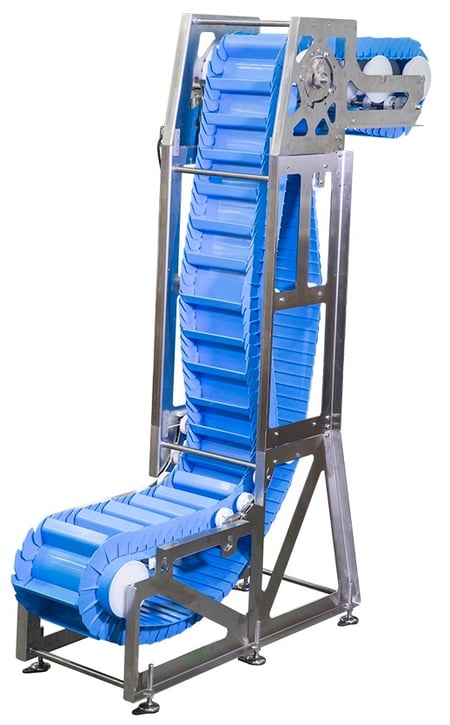 Also important to keep in mind when researching sanitary platforms is where in the plant the conveyor is located. For applications more downstream in processing where the conveyor is moving sealed and packaged food, the conveyor might not need to be as hygienic as those carrying raw food and ingredients. These conveyors often accumulate corrugated dust from the cardboard packaging, and that can be cleaned by washing or simply wiping down the conveyor. This conveyor is still sanitary in design, but for this application the more robust sanitary platform isn’t commonly required.
Also important to keep in mind when researching sanitary platforms is where in the plant the conveyor is located. For applications more downstream in processing where the conveyor is moving sealed and packaged food, the conveyor might not need to be as hygienic as those carrying raw food and ingredients. These conveyors often accumulate corrugated dust from the cardboard packaging, and that can be cleaned by washing or simply wiping down the conveyor. This conveyor is still sanitary in design, but for this application the more robust sanitary platform isn’t commonly required.
Interested in a Dorner Conveyor?
Interested in Learning More?
Please fill out our contact form, and a member of the Knotts Team will get in touch to help you.
%202.png?width=323&height=215&name=PH_VA_VR_Series_Technical_Support%20(1)%202.png)


